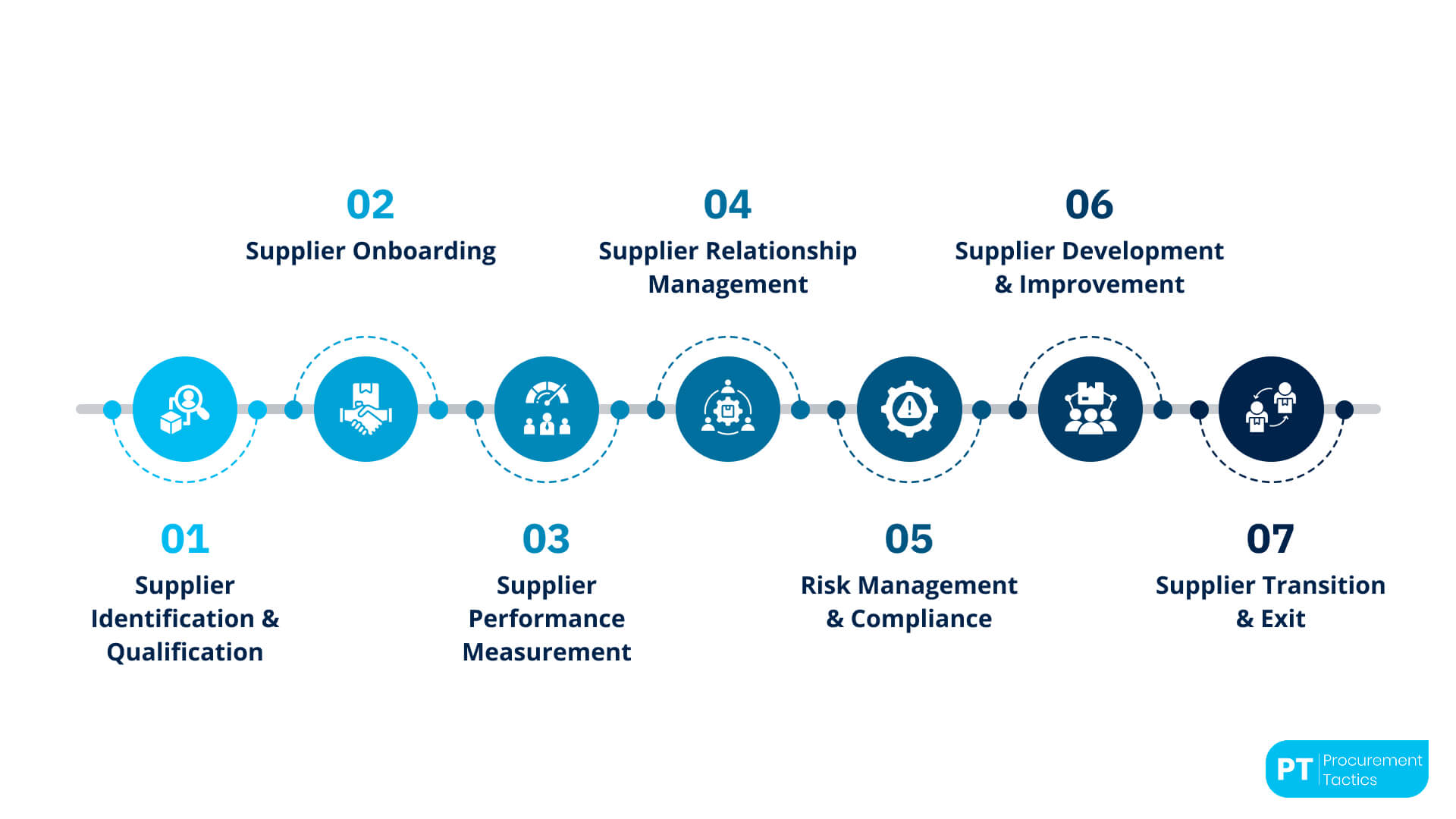Written by Marijn Overvest | Reviewed by Sjoerd Goedhart | Fact Checked by Ruud Emonds | Our editorial policy
Supplier Management Process — Explained + Best Practices

As taught in the Supplier Relationship Management Course / ★★★★★ 4.9 rating
What is a supplier management process?
- The supplier management process represents a structured procedure for identifying, evaluating, and managing suppliers to ensure service or product reliability and quality.
- The supplier management process includes negotiation, performance monitoring, and risk analysis, enabling timely corrective actions and improving cooperation.
- The supplier management process aims to build long-term relationships with suppliers, optimize procurement, and achieve a more efficient supply chain.
What is Supplier Management?
Supplier management represents the strategic and operational process of identifying, qualifying, onboarding, and managing suppliers to maximize their value to the business.
This process goes beyond just selecting vendors—it includes continuous performance monitoring, compliance management, and developing long-term collaborative relationships.
An effective supplier management program typically includes the following:
- Vendor onboarding and qualification
- Risk and compliance monitoring
- Invoice and payment management
- Performance evaluation and continuous improvement
- Strategic collaboration and innovation
The ultimate objective is to maximize returns on supplier spend while reducing risks such as delivery delays, quality failures, and invoice fraud. By consolidating supplier data and streamlining workflows, organizations simplify procurement operations, enhance budgeting accuracy, and build stronger supply chain resilience.
The 7 Steps of the Supplier Management Process
An effective supplier management process ensures organizations build long-term, value-driven relationships with suppliers while minimizing operational risk. Below are the essential steps, each accompanied by a real-life example to illustrate practical application.

1. Supplier Identification and Qualification
Organizations must first identify potential suppliers that meet predefined criteria such as quality, cost, reliability, capacity, and compliance. This step often involves market research, competitor analysis, and participation in industry events.
Expanding on the initial statement, companies can follow steps to identify potential suppliers that align with key criteria (quality, cost, reliability, capacity, and compliance). Here’s an expanded framework:
- Define Criteria: Set key requirements such as quality, cost, reliability, capacity, and compliance.
- Market Research: Use industry analyses, online directories, and databases to locate potential suppliers.
- Competitor Analysis: Check which suppliers competitors use and establish benchmark standards.
- Networking: Attend trade shows, conferences, and consult with expert groups for recommendations.
- Pre-Qualification: Send RFIs and surveys to gather initial supplier information.
- Evaluation: Compare offers and conduct site visits or virtual inspections to verify capacities and conditions.
- Consultations: Seek expert opinions and client references.
- Finalization: Develop a final supplier list and document the evaluation process.
Real-life example
As a procurement manager at Royal FrieslandCampina, I used international food expos in Germany to discover local suppliers of dairy additives. Additionally, I analyzed supplier partnerships used by competitors to identify reliable sources and benchmark quality standards.
2. Supplier Onboarding
Once selected, suppliers are formally onboarded through contracts that outline pricing, delivery timelines, service levels, and legal conditions. Required documentation is collected, including certificates, insurance, and tax compliance, followed by orientation sessions on company procedures.
Real-life example
While working with Ahold Delhaize, we digitized supplier onboarding for fresh food vendors. We introduced a secure document portal for uploading certificates (e.g., HACCP) and conducted short virtual training to align suppliers with our delivery and packaging requirements.
3. Supplier Performance Measurement
Supplier performance must be tracked continuously using defined KPIs such as quality, delivery accuracy, responsiveness, and cost efficiency. Regular evaluations via audits, scorecards, and feedback loops help maintain alignment and accountability.
Real-life example
With a key packaging supplier, we conducted quarterly business reviews using a standardized KPI deck. Metrics like delivery timeliness and claims ratio were tracked. Within six months, the service level improved from 85% to 98% after joint corrective actions were implemented.
4. Supplier Relationship Management
Strong relationships with key suppliers are essential for collaboration, innovation, and issue resolution. Trust, open communication, and shared goals are central to long-term partnerships.
Strong relationships with key suppliers turn routine transactions into strategic partnerships. By fostering trust, maintaining open communication, and aligning on shared goals, both parties integrate more closely into each other’s planning and operations. This integration leads to:
- Enhanced Collaboration – Suppliers become an extension of the organization, offering insights and helping streamline processes.
- Joint Innovation – A trusted partnership encourages collaborative R&D and the development of new solutions.
- Effective Issue Resolution – Open communication facilitates the rapid identification and resolution of challenges, reducing potential disruptions.
Real-life example
In collaboration with a top e-commerce supplier at Ahold, we initiated a joint project to reduce product damage during last-mile delivery. By redesigning packaging, we lowered product returns by 35% in just one quarter.
5. Risk Management and Compliance
Risk identification and mitigation are critical throughout the supplier lifecycle. Organizations must ensure suppliers comply with legal, regulatory, and ethical standards while also preparing for geopolitical, financial, and supply-related disruptions.
There are several ways companies can ensure that their suppliers remain compliant with legal, regulatory, and ethical standards throughout the supplier lifecycle:
- Regular Audits & Inspections (Conduct periodic on-site audits and third-party reviews).
- Due Diligence (Perform background and financial checks before onboarding suppliers).
- Certifications (Require relevant certifications (e.g., ISO) and validate them regularly).
- Contractual Clauses (Include clear compliance expectations and penalties in contracts).
- Digital Monitoring (Use software tools for real-time supplier performance tracking).
- Code of Conduct (Enforce a supplier code covering legal, ethical, and environmental standards).
- Open Communication (Maintain regular dialogue and training sessions).
- Corrective Actions (Establish clear remediation processes).
- Trend Monitoring (Stay updated on regulatory and geopolitical changes).
- Self-Assessments (Encourage suppliers to perform regular internal reviews).
Real-life example
During the COVID-19 crisis, we activated a backup supplier network for packaging materials after our primary Italian supplier was affected by lockdowns. Risk maps were updated bi-weekly, and origin certificates were revalidated as part of crisis protocols.
6. Supplier Development and Improvement
Suppliers must grow with your business. Supporting their development through training, guidance, and knowledge-sharing helps enhance capabilities, drive innovation, and meet rising performance standards.
Real-life example
We helped a small cheese producer in the Netherlands improve hygiene standards by providing technical guidance and FSSC templates. Within three months, the supplier earned certification and was onboarded as a core vendor for retail delivery.
7. Supplier Transition and Exit
Regular supplier reviews can reveal performance gaps or strategic misalignment. When necessary, transitioning to alternative suppliers should be carefully planned to avoid disruptions.
Real-life example
We replaced a regional distributor due to workforce instability and recurring delays. A structured three-month overlap with the new supplier ensured seamless delivery to our retail stores, maintaining service continuity without stockouts.
Supplier Management Process vs. Supplier Management System
While the supplier management process and a supplier management system are closely related, they are not the same. The process refers to the strategic, often manual, workflow that procurement teams follow to build, maintain, and evaluate supplier relationships. On the other hand, the system is a digital tool that supports and automates this process.
Understanding the distinction is essential when designing a procurement strategy that balances human insight with technological efficiency. Here’s a quick comparison:
Benefits and Challenges of the Supplier Management Process
In a dynamic business environment, where the complexity of procurement and the number of simultaneous requests from different sectors are increasing, implementing a supplier management process becomes essential for the effective functioning of an organization.
This process enables the monitoring and management of suppliers in accordance with internal guidelines, identifies potential areas for improvement, and contributes to the overall enhancement of the supply chain.
Main Challenge of the Process
Operational Advantages of Implementation
5 Best Practices For Supplier Management Process
A well-implemented supplier management process is crucial for aligning supplier performance with strategic business objectives and maintaining a competitive edge. The following best practices provide a roadmap to drive operational efficiency and build long-term supplier relationships.
1. Set Strategic Objectives and Define KPIs
Establish clear and measurable supplier management objectives that align with your business priorities. Define key performance indicators (KPIs) such as defect rate, lead time, order accuracy, and pricing competitiveness.
These KPIs enable continuous monitoring and evaluation of supplier performance, laying the groundwork for process improvement and optimal results.
Example
A consumer electronics manufacturer aims to reduce the defect rate by 10% and decrease lead time by 15%. They define KPIs such as defect rate, lead time, order accuracy, and pricing competitiveness, which allow them to continuously monitor supplier performance and drive process improvement.
2. Adopt a Centralized Supplier Management Database
Implement a unified digital platform that integrates Supplier Information Management (SIM) or Supplier Relationship Management (SRM) solutions.
A centralized database ensures precise data collection, storage, and analysis, reducing administrative burden while maintaining data consistency. This, in turn, facilitates informed decision-making in real time.
Example
A company implements a unified digital platform, such as SAP SRM, to consolidate all supplier information into one central database. This integration ensures accurate data collection and analysis, reduces administrative overhead, and enables real-time decision-making.
3. Enhance Risk Assessment Processes
Establish a systematic approach to identify and evaluate all potential risks—financial, legal, operational, and reputational. Regular risk analyses help you detect and address vulnerabilities in the supply chain promptly.
This proactive approach minimizes the likelihood of errors, fraud, or supply disruptions, thereby ensuring operational stability.
Example
The organization conducts quarterly risk assessments, evaluating financial stability, legal and operational risks, and monitoring geopolitical developments. This proactive approach helps identify and mitigate vulnerabilities in the supply chain before they lead to disruptions.
4. Strengthen the Supplier Onboarding Process
Optimize and automate the integration process for new suppliers to expedite registration and ensure the collection of all necessary information and documentation.
Clearly defined and standardized onboarding steps ensure compliance with internal guidelines and regulations, establishing a solid foundation for long-term, reliable supplier relationships.
Example
New suppliers are onboarded through an automated online system that requires completion of standardized forms, submission of necessary documentation, and verification of compliance with company guidelines. This ensures that every supplier meets internal and regulatory requirements from the start.
5. Integrate Automation and Self-Service Options
Leverage advanced SIM and SRM software tools to automate key activities such as contract management, performance monitoring, and data updates.
By providing self-service options for suppliers, you reduce manual interventions, improve data accuracy, and streamline workflows. This integration leads to higher operational efficiency and significant resource savings.
Example
The company uses advanced SIM and SRM software to automate tasks such as contract management, performance tracking, and data updates. Suppliers can also access a self-service portal to update their information independently, which minimizes manual interventions and enhances overall operational efficiency.
Conclusion
An efficient supplier management process is a key element in ensuring the stability and competitiveness of the supply chain. Through careful planning, implementation, and control, companies can not only optimize costs but also minimize risks such as delivery delays, quality issues, and financial irregularities.
The clearly defined steps—from the identification and qualification of potential suppliers, through their successful onboarding, to continuous performance monitoring and strategic relationship development—enable the creation of long-term, value-oriented partnerships.
Additionally, integrating digital tools and centralized management systems facilitates transparency, more efficient data processing, and faster decision-making. By enhancing risk assessments and compliance, as well as continuously evaluating and improving performance, companies achieve not only better operational efficiency but also greater adaptability in a dynamic business environment.
Frequentlyasked questions
What is a supplier management process?
A supplier management process is a systematic series of steps designed to identify, onboard, and continuously evaluate suppliers.
Why is managing suppliers important for companies?
Managing suppliers through a supplier management process helps companies optimize costs, reduce risks, and ensure timely, high-quality deliveries.
What are the main steps in supplier management?
The main steps in a supplier management process include identifying potential suppliers, onboarding them, monitoring their performance, managing relationships, assessing risks, and developing supplier capabilities.
About the author
My name is Marijn Overvest, I’m the founder of Procurement Tactics. I have a deep passion for procurement, and I’ve upskilled over 200 procurement teams from all over the world. When I’m not working, I love running and cycling.






